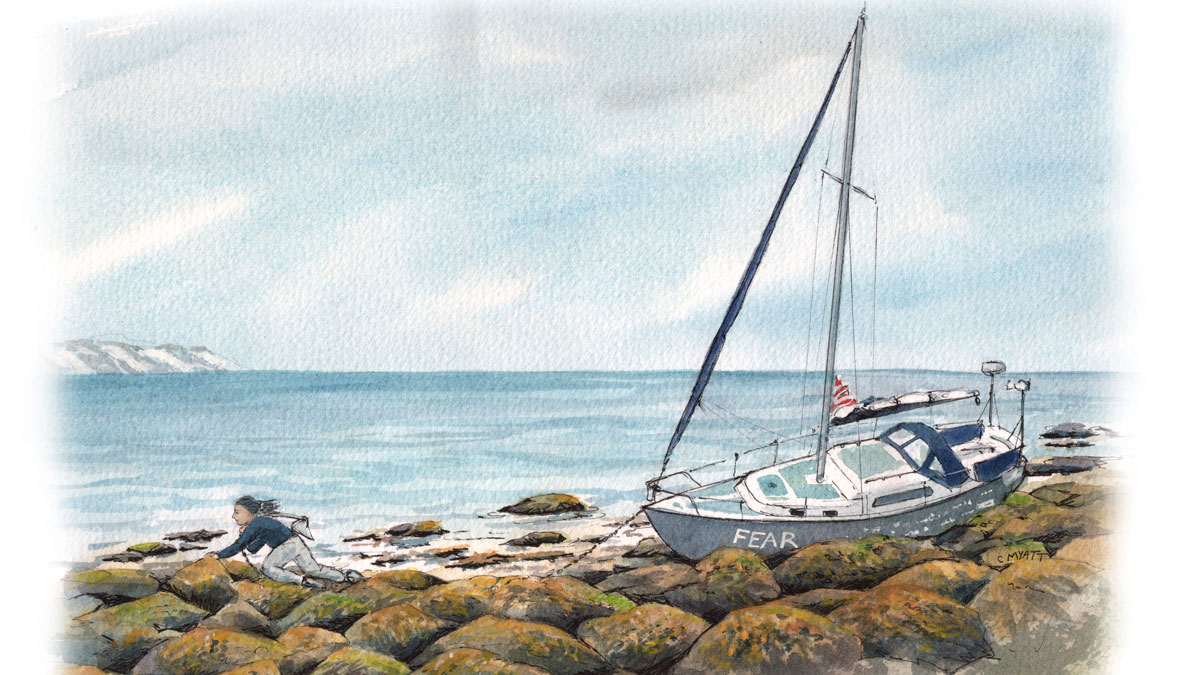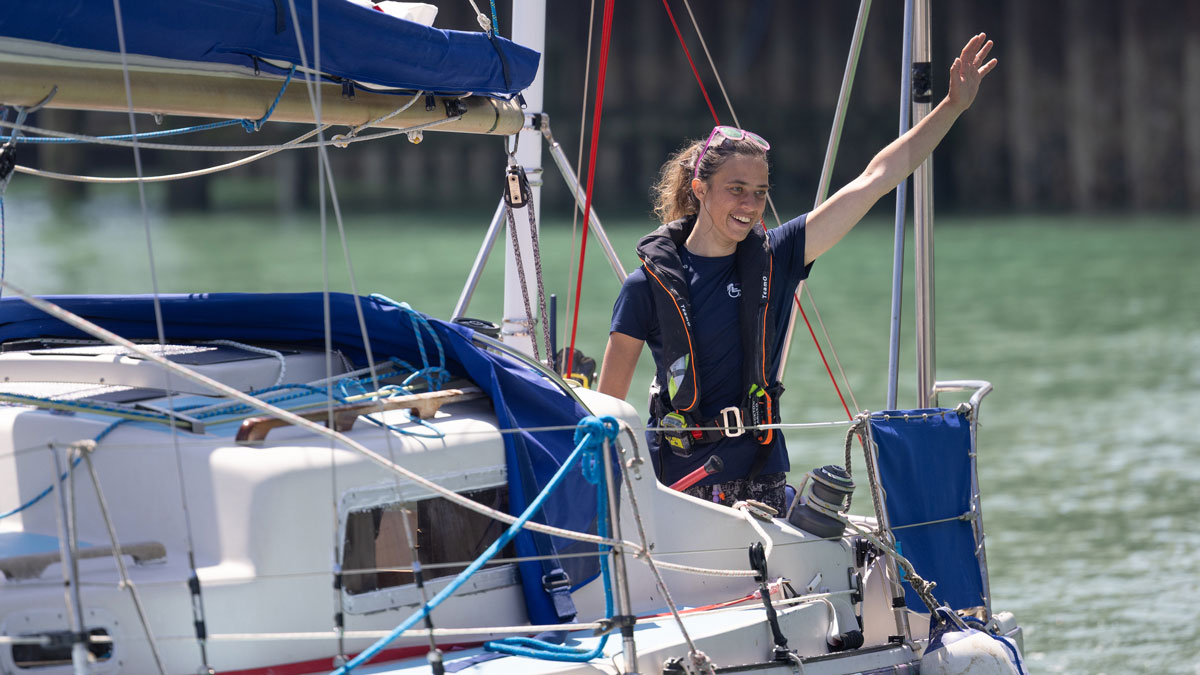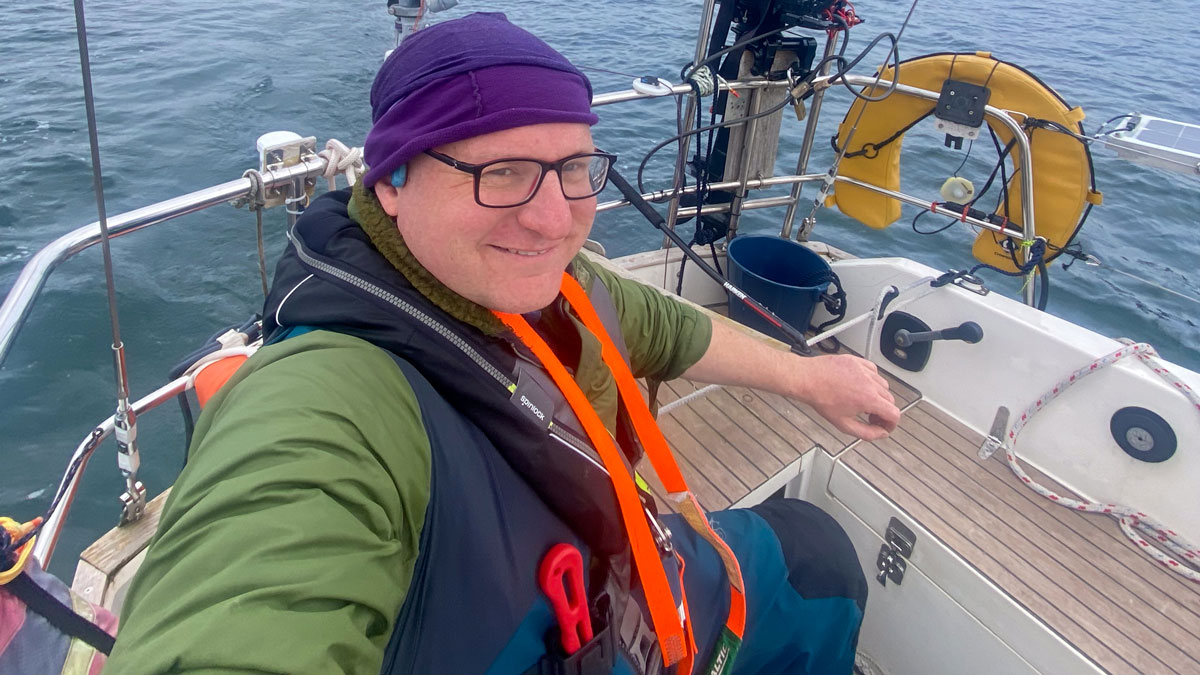In her own words, adventurer and disabled sailor Jazz Turner reflects on her recent record-setting UK and Ireland circumnavigation and her decision to turn down a hospice bed and ‘get out into the English Channel and turn right’
Little did I know, when I set off from Brighton Marina on 2 June at 1230, that the next 28 days would test me in far more ways than I could ever imagine.
I was attempting to set the record as the first female and first disabled person to complete a solo, non-stop and unassisted circumnavigation of the UK and Ireland.
I didn’t know it at the time, but it would be some of the most difficult and tricky sailing I would ever do.
It would also be some of the most incredible and rewarding sailing I’d ever had the privilege to experience.
Heading south-west from Brighton Marina slowly, the five or six support boats peeled away and I was left alone with my Albin Vega 27, Fear.
There was an enormous sense of peace as after all the hard work we were finally doing it.
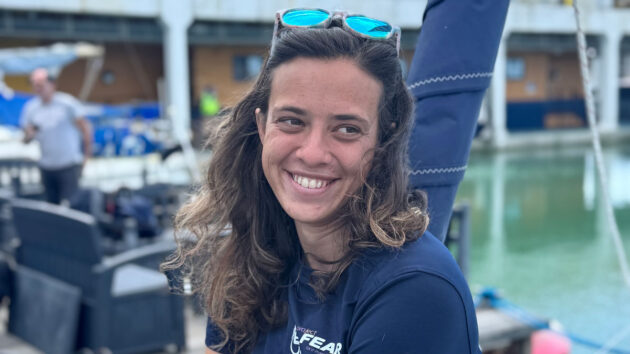
Jazz Turner aboard her 27ft 1975 Albin Vega yacht, FEAR. Photo: David Martin
Daunting start
Heading off into a strong south-westerly meant that to make progress I had to tack upwind.
It was on the third tack, just off Shoreham harbour where, as the breeze picked up, I mistimed the tack and dropped the winch handle, cracking the screen of my chartplotter.
It still worked, which is a testament to Raymarine kit, but from then on it didn’t like getting wet.
This wasn’t ideal seeing as I was potentially spending the next eight weeks at sea.
It was only then that the sheer scale of the challenge sunk in.
All I could think was ‘what the hell am I doing?’
The wind didn’t drop below 20 knots for the first four days and it was all upwind, which was equally difficult conditions for both me and the boat.
My first week was characterised by a series of breakages: first the chartplotter, then the electronic compass, followed by the water tanks breaking free and finally the windows started leaking.
By the time I reached my first anchorage off Falmouth on day five, I was exhausted and feeling pretty low.
The time at anchor allowed me to re-set and refuel as well as carry out repairs as best I could.
This meant re-drilling holes for the support straps for my water tanks, covering the windows in silicone sealant (I may have got even more sealant on my salopettes) and falling back on the tried and tested tech hack of turning my compass off and on which seemed to fix it.
Pivotal moment
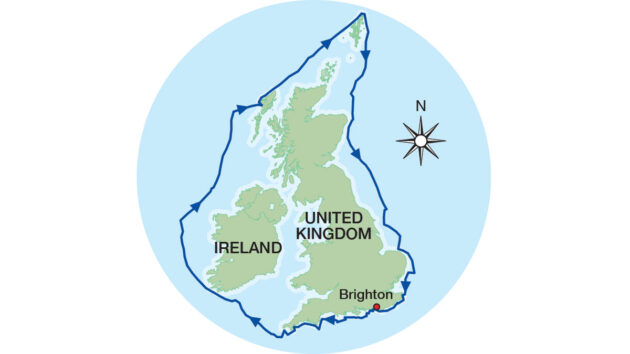
Jazz Turner’s clockwise route around the UK and Ireland
By day seven the weather window opened for my crossing over to Ireland, and I was itching to get going again.
The Irish Sea gave me my first real taste of offshore sailing, with nothing in sight except sea and sky there was a real sense of freedom.
You ate when you were hungry, slept when tired and always kept sailing, no real sense of time passing.
Passing Fastnet Rock on day 11 was a monumental moment for me.
When I started sailing keelboats three years earlier, I’d been told that doing the Fastnet Race was something someone with my disability couldn’t do.
So, to pass the most southerly point of Ireland and to do so in a way that was trickier, being solo, felt like the first affirmation of maybe I can just do this.
It also marked the first time the wind went behind me, meaning I made rapid progress up the west coast of Ireland.
I reached St Kilda on day 14 marking my halfway point as the crow flies at 1,000 miles.
However, having already sailed over 1,200 miles I was expecting to have a lot further to go before getting home.
After a brief anchorage stop to rest and refuel my body, I pushed on up to the Shetlands.
Seeing Muckle Flugga, the northernmost point of the British Isles, come into sight on day 19 was incredibly emotional, a mixture of sheer disbelief and excitement that I’d made it that far.
It meant that all the miles from then on would take me south and closer to home.
Homeward stretch
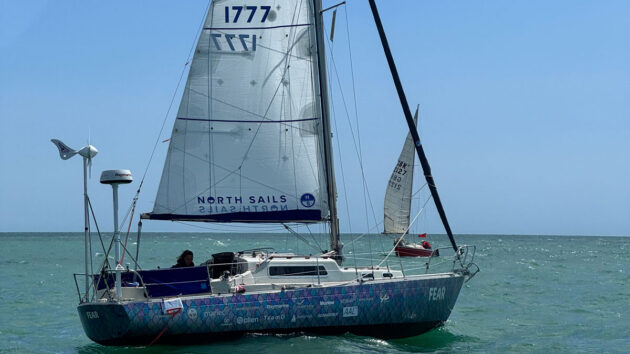
Jazz Turner aboard her mermaid-scale decorated 27ft 1975 Albin Vega yacht FEAR. Credit: David Martin
Passing down the East Coast marked the biggest change, with shipping increasing drastically and the navigation getting increasingly complex.
At times it felt like I was slaloming between oil rigs, wind farms and tankers. With strong winds the North Sea generated a short, sharp chop that was uncomfortable to sail through.
All of that meant I got very little sleep.
There is a rough rule in offshore sailing, that to stay sane you need to get roughly four hours every 24 hours.
To say I was nowhere near this would be an understatement.
Having alarms for both the Automatic Identification System (AIS) receiver and AIS transmitter is key for a journey like this one.
I also learned the importance of keeping your VHF radio volume on loud so that if anyone wants to make contact, you can hear them (there was an occasion when I had mine turned down, and for 20 minutes I missed being called on Ch16).
Abrupt halt
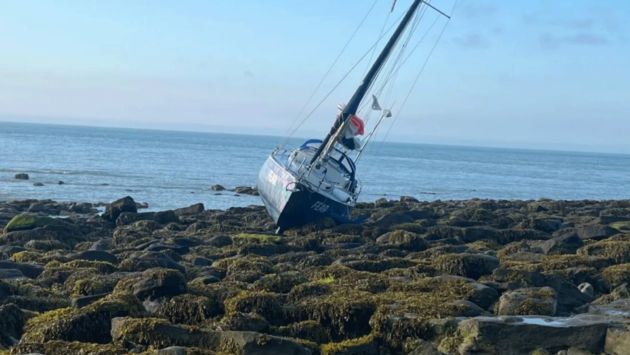
Jazz Turner independently refloatied her boat off Folkestone. Photo: Jazz Turner via Instagram
It was as I was passing Felixstowe and Dover that the whole trip nearly ended.
Tacking inshore to escape the strong tide, I fell asleep and accidentally ran the boat aground just outside Folkestone Harbour.
My initial thought was just panic, that I had destroyed Fear and that it was all over so close to home.
Once I’d assessed there was no significant damage, it was a case of formulating a plan, with the Coastguard, the Royal National Lifeboat Institution (RNLI) and my shore team.
The decision was made that I’d attempt to refloat her independently, using two anchors, one off the bow and one off the stern to pull her into deeper water as the tide came in.
Sounds simple but crawling two 10kg anchors 40m across rock was hard work.
I was born with a genetic condition called hypermobile Ehlers-Danlos Syndrome, which means my joints are prone to dislocation.
I also have associated conditions including mast cell activation syndrome which causes random allergic reactions; postural orthostatic tachycardia syndrome which means I pass out regularly, usually triggered by a change in position; and gastroparesis and gastrointestinal failure that means I am unable to eat or drink and am fed through a central line directly into my heart, as well as underlying heart failure.
Constantly dislocating joints, meant I was in a lot of pain during this trip.
My hands got really swollen and painful.
Sailing again
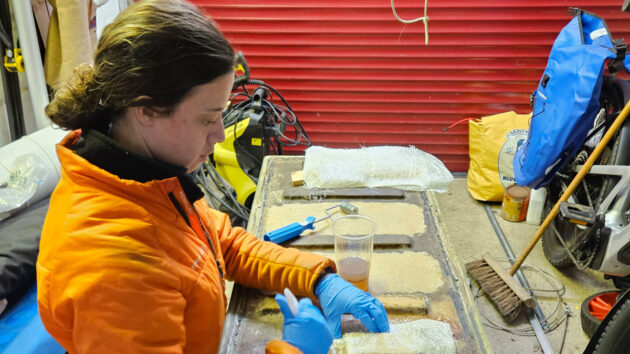
Boat work and voyage preparations “kept me going at a time when I didn’t see any hope,” says Jazz, who was given six months to live. Credit: Jazz Turner
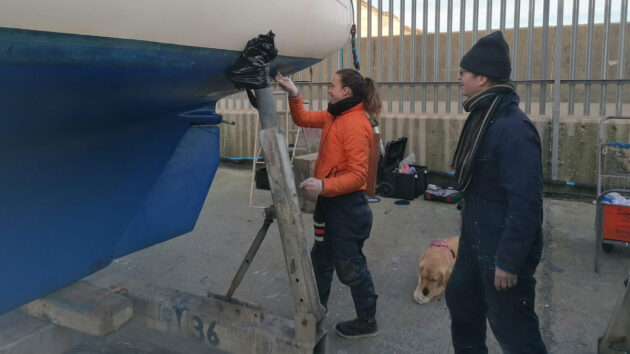
Jazz, a mechanical engineering graduate, and foster dad Chris, a retired engineer, rebuilt Fear from the ground up, “total rewiring and everything else”. Credit: Jazz Turner
Still, the plan was successful, and I was able to refloat her successfully, meaning the record attempt still stood.
Light winds and strong tide made the last 50 miles back home tortuously slow going. I was so close and yet so far.
But at the same time, I started to be met by the 25 to 30 boats who had been following my journey and wanted to see the finale.
It was the first time I started to understand how far Project Fear had gone.
I was told I had six months to live in December 2023 and it was nearing the end of those six months that I faced the question, how do you live when you don’t know how long you have left to live?
That’s when Project Fear was born.
I’d been offered a bed in a hospice, but instead decided to get out into the English Channel and turn right.
As an acronym, FEAR could mean ‘forget everything and run’, but I want to show the world that when faced with difficult challenges, it is better to ‘face everything and rise’.
This voyage started out as simply something to keep me going at a time when I didn’t see any hope, and yet it had become something that went far beyond me and my little boat.
Incredible relief
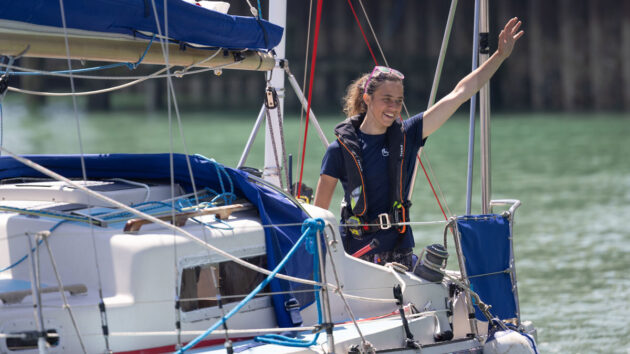
Jazz was spurred on by messages from sailing legends such as Sir Ben Ainslie, Dame Ellen MacArthur, Pip Hare, Hannah Stodel and Ian Walker
Crossing that finishing line on 1 July at 1330 just outside Brighton marina was incredible.
There was a sense of relief as well as astonishment that we’d done it.
I may have sailed solo, but it took a whole army of supporters to get us to where we are today – from every person who donated, shared or followed my journey, to my amazing sponsors, who took a punt on my challenge as, when we started, we really didn’t know if it would be possible.
At times it felt like the odds were against us and yet we made history: 28 days and one hour, and 2,070 miles after setting off, I returned home, setting two records as the first female and first disabled person to complete a solo, non-stop and unassisted circumnavigation of the UK and Ireland.
My welcome home was made even more special by the crowd who came to support me.
You always expect your friends and family’s support but it was humbling to see the people I had never met, yet who were invested in me and my journey.
It was an honour to wave to them and to realise that my crazy dream had turned into a very real reality.
However, this project was always about far more than the record.
It was about raising money for Newhaven and Seaford Sailability (NSSS).
This is an organisation I founded alongside my parents in 2019, to support other people with disabilities to experience the joy and freedom that I am lucky enough to get every day.
NSSS was founded because when I transitioned out of ‘normal’ dinghies I found my options were limited.
The Sailability sites that I could attend wouldn’t accept me without ‘able’ bodied helpers on board because of the complexity of my condition.
I was frustrated as, despite having recently won my first world championship, I felt like I was suddenly being treated differently just because I couldn’t hike anymore.
NSSS was created to try and cultivate the community I wanted around me.
In particular, to support and develop younger sailors who may be interested in racing, at club level or beyond.
Last year we got our participants racing alongside other club members in our winter series, with junior cadets providing the support to enable this to happen.
A key focus is integration not only in club activities but within the wider sailing community. I am passionate that we should focus on inclusion.
Making waves
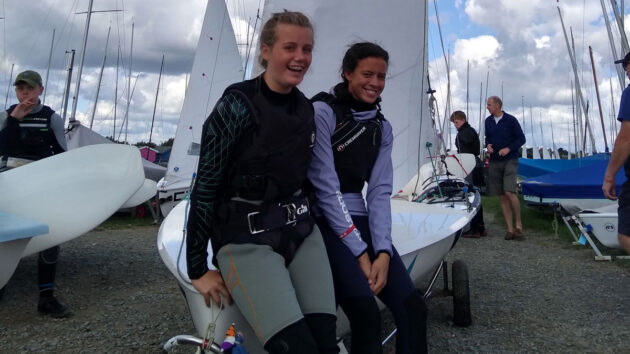
As a dinghy sailor, Jazz Turner has represented Great Britain as an able-bodied and a disabled athlete. Credit: Jazz Turner
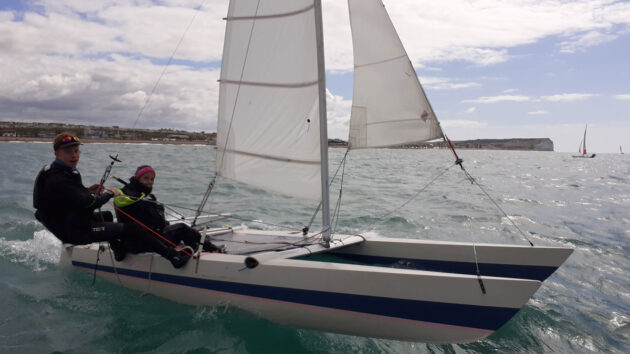
The thrill of sailing is something Jazz is passing on to others through Newhaven and Seaford Sailability. Credit: Jazz Turner
We’re a long way from where we started with two donated boats and one participant – me.
We now have nine boats and support more than 50 people every year to access sailing regularly. However, to continue to do this we needed money and so the Project Fear aim was to raise £30,000.
I am incredibly glad to say we have raised over £58,750.
This money will buy adaptive equipment to get more sailors out on the water and also enable me to offer free coaching and support to existing and new sailors.
Everyone has asked ‘what’s next?’
For now, my priority is fixing up Fear.
I’m sure there will be more adventures, but for now I’m still getting over this one!
Lessons learned
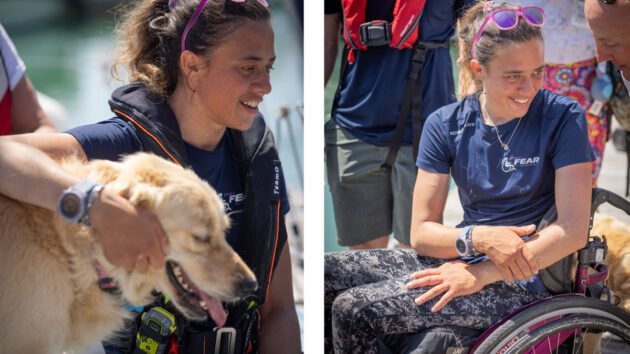
Jazz Turner with her beloved adopted dog Phoebe, and pictured in her wheelchair at the voyage finish at Brighton Marina. Credit: Fergus Kennedy
- You can never have enough silicone sealant, and it can solve almost any problem.
Duct tape is also your best friend for temporary repairs on the move. It lasts a surprisingly long time. - Being offshore is my favourite kind of sailing.
My first taste was the Irish Sea and being able to see nothing but sea and sky was pure freedom. - Anchoring and resting is not failing; instead, sometimes it is the bravest thing you can do to listen to your body and stop despite wanting to make forward progress.
- AIS alarms! Having both the AIS receiver and AIS transmitter is key for a journey like this one.
- Always make sure your VHF radio volume is on loud so if anyone wants to communicate with you, you can hear them.
(Note: I may have had mine turned down and missed being called on Ch16 for 20 minutes) - Contacting HM Coastguard and the RNLI doesn’t mean they have to help you, it can just be used to help you form a plan of action so everyone understands how best to support you in the particular situation.
- Always have a spare anchor, you never know when you might need it!
- Having that first shower, seeing my dog, Phoebe, and home comforts after a month at sea felt amazing.
Expert comment
Hannah Stodel, Para World Sailing manager, coach and weather router, says:
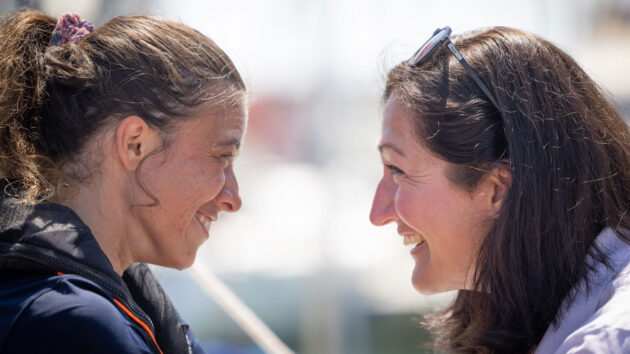
Jazz Turner and Hannah Stodel share a poignant moment at the circumnavigation finish. Photo credit: Fergus Kennedy
“When Jazz first told me she was planning to solo circumnavigate the UK and Ireland, non-stop, unassisted, in an Albin Vega, with her health where it was, I had two reactions:
“1) that’s ridiculous, and 2) of course she’s going to do it.
“As a sailor, Jazz is relentlessly determined, smart, and utterly resourceful. As a person, she’s even more so.
“Coaching and routing for her through this challenge was like being part of a rolling masterclass in perseverance – from patching leaks with silicone to hand-hauling anchors while dislocating her joints.
“It was an epic mix of practical seamanship, absolute grit, and one of the most powerful ‘why not?’ challenges I’ve ever seen thrown down.
“The setbacks she faced would have stopped most people in their tracks – fatigue, gear failure, running aground, pain – but she kept moving forward, day after day.
“She made hard decisions, trusted herself, and somehow found humour even in the most brutal conditions.
“That kind of resilience isn’t something you teach; it’s something you uncover when you refuse to give up.
“I’ll never forget the moment she crossed that finish line. I was there, and we both just cried.
“She looked at me and said, ‘I didn’t think I could do it.’
“I just smiled through the tears and said, ‘I did.’
“Because that’s what we all need when we face the impossible – someone who believes in us, even in the moments we don’t believe in ourselves.
“I was proud to be that person for Jazz. And she has been an inspiration for others by showing what’s possible.
“What Jazz achieved goes beyond records (though she set two!).
“This was about taking up space in a world that often says ‘no’. About reminding us that adventure doesn’t belong to the able-bodied – it belongs to those bold enough to say ‘I’ll give it a go’.
“Watching her sail in was one of the most powerful moments I’ve witnessed.
“And it’s only the beginning of what she’s capable of.
“I’ll be cheering her on for wherever her compass points next.
Sam Hughes, RNLI National Water Safety Partner, says:
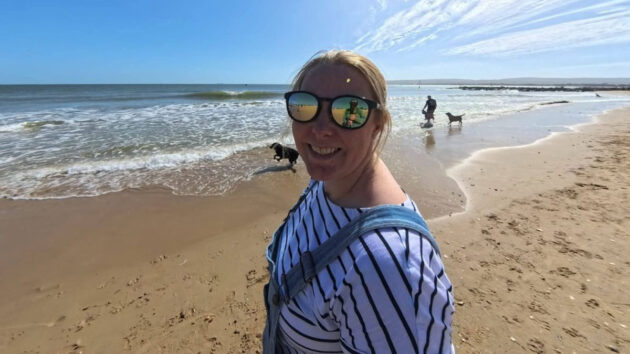
Sam Hughes, RNLI National Water Safety Partner
“Warm congratulations to Jazz on her record-making achievement.
“It’s brilliant to read about the freedom and exhilaration she found in offshore sailing.
“We often focus on the physical demands of these challenges, but we shouldn’t underestimate the equal value of a self-sufficient and problem-solving mindset at sea.
“These skills can save your life just as much as physical strength.
“A non-stop challenge brings up all sorts of pressures – not just your own hopes, but the expectations of your amazing supporters and sponsors.
“This can inadvertently cloud your judgement, but Jazz was always aware of not compromising her own or the boat’s safety.
“Have a suitable anchor plus a spare, and don’t be afraid to use them!
“Whether it’s you who needs a rest or something’s up with your boat or the conditions, anchoring buys you time to regroup, calmly evaluate things and make a plan.
“Holding position also makes it easier for our crews to find you if needed – it takes the ‘search’ out of search and rescue.
“Before your voyage, training helps you prepare for the unexpected.
“Skill fade is real – it’s why our lifeboat crews train every week.
“It’s much safer to practise in a controlled environment than when something goes wrong for real.
“Go over crew briefings, manoeuvres, emergency action plans and scenarios like man overboard and anchoring, so you know you have the right equipment to help you.
“Finally, Jazz’s self-rescue is a great example of calling the Coastguard when something’s wrong, but not yet an emergency.
“It’s not always about an immediate rescue or tow.
“Making the call means you can keep the Coastguard in the picture and plan with them.
“Lifeboat crews can be placed ready on standby, or they may launch to keep watch while you refloat and intervene if it’s needed.
“Everyone in search and rescue is here to work with you to make sure you’re safe.
“Whether you’re planning a solo sailing adventure or heading out with your crew, make sure you’re ready with our boating checklists: RNLI.org/BoostSkills.”
About Jazz Turner
Jazz Turner started sailing at 13 and fell into it by accident when a friend gave her an unwanted learn to sail voucher. But from that first sail right up to today, it has been the joy and sense of freedom on the water that has kept her coming back.
Having grown up in an abusive household, finding crewing opportunities at Newhaven and Seaford Sailing Club provided Turner with an escape – and a new family – as she met her foster-partents-to-be, Chris, a retired engineer and Fireball dinghy sailor, and his wife Carolyn, a general practitioner, who gave her a home from the age of 18 when she had left home for her own safety and was living in a campervan.
As a dinghy sailor, Turner has represented Great Britain on the international stage both as an able-bodied and a disabled athlete.
She started sailing keelboats at the end of 2022 when, with sailing having been dropped from the Paralympic Games line up, she wanted something else to focus on.
Frustrated by the lack of opportunities, due to people’s fear of her disability, Turner bought her own boat in October 2024.
Fear was chosen specifically for her seaworthiness for the UK and Ireland circumnavigation.
The Per Brohäll-designed 8.25m Albin Vega 27, inspired by Sweden’s interesting coastline, was designed to be tough with an encapsulated keel and keel-hung rudder.
Adventurer and disabled sailor Jazz Turner has set her sights on another circumnavigation, this time global – the WorldStar Race.
Jazz Turner reflects on her circumnavigation achievement of being the first disabled person to sail solo, non-stop and unassisted around…
Ian Wyllie of Sailing Trilleen has completed a solo multi-year circumnavigation of the UK and Ireland in the 1979 Vancouver…
Want to read more articles like this?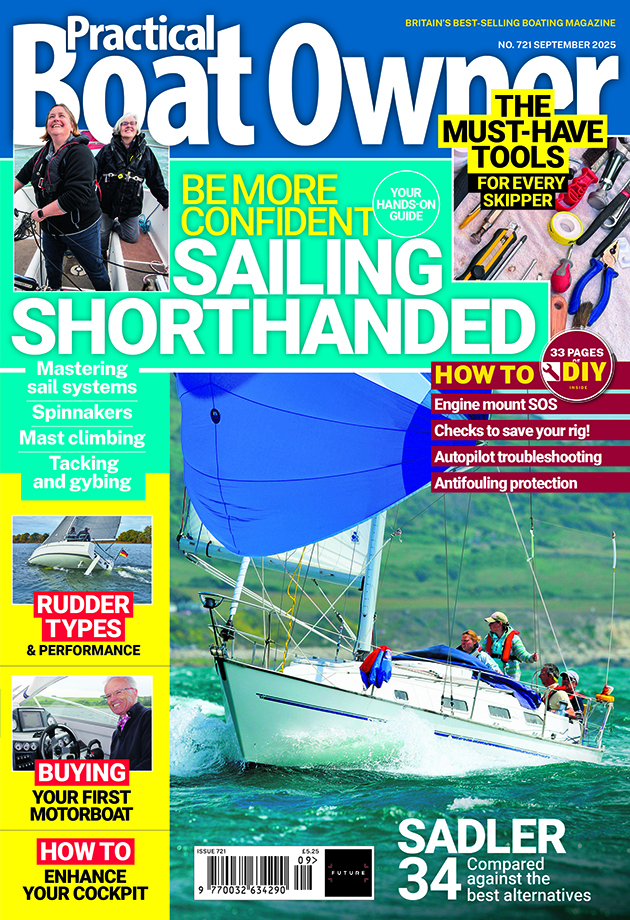
A subscription to Practical Boat Owner magazine costs around 40% less than the cover price.
Print and digital editions are available through Magazines Direct – where you can also find the latest deals.
PBO is packed with information to help you get the most from boat ownership – whether sail or power.
-
-
-
- Take your DIY skills to the next level with trusted advice on boat maintenance and repairs
- Impartial, in-depth gear reviews
- Practical cruising tips for making the most of your time afloat
-
-
Follow us on Facebook, Instagram, TikTok and Twitter
